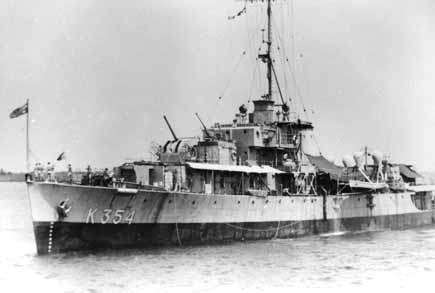- Author
- Newspaper, The West Australian
- Subjects
- RAN operations, Ship histories and stories, WWII operations
- Tags
-
- RAN Ships
- HMAS Gascoyne I
- Publication
- June 2007 edition of the Naval Historical Review (all rights reserved)
Editor’s Note: This article appeared in the West Australian newspaper late in 1949, and comes to us from Mr Paul Rooke, via his friend and fellow ex-Navy man, Graham Dennis. Mr. Rooke, as an Able Seaman, was serving aboard HMAS Gascoyne during the incident described. Unfortunately, the West Australian was unable to confirm the origin of the article.
In a violent tropical rainstorm on Christmas night, 1944, the crew of a small ship of the Royal Australian Navy, HMAS Gascoyne, dramatically rescued from fire about 1300 men, mostly American troops, who were aboard the Dutch transport Sommelsdijk (9227 tons), then lying with other vessels in the harbour at Guian, Samar Island, in the Philippines.
They also saved the Sommelsdijk herself from destruction. As a result of the exploit, in which the rescuers were hampered not only by driving rain, but also by rolling clouds of smoke which made visibility almost negligible, three members of Gascoyne’s crew were decorated and another mentioned in despatches.

At the time, Gascoyne was part of a hydrographic task group operating in Philippine waters and had dropped anchor after she had been engaged in surveying the Guian roadstead throughout Christmas Day.
The Allies were building a big aerodrome nearby, and it had become necessary to bring stores, machinery and all kinds of equipment into the harbour in ships of fairly deep draught. The charts that the Allies had did not show much detail and were not considered sufficiently reliable for taking big ships in close to land, except in cases of urgency. Gascoyne had therefore been allotted the job of preparing a better chart.
Her officers and crew knew that it would be dangerous work, and that they, and their small vessel, would probably become the target for numerous Japanese bombers.
Under-surface dangers
They had, for instance, learned how active Japanese airmen could be when their ship had preceded the big warships into Leyte Gulf on the Allies return to recapture the Philippines in October.
Three days before the Allied landing on October 20, and the day before the battleships and cruisers of the bombardment and assault group arrived, Gascoyne, accompanied by an Australian harbour defence launch and two American minesweepers, entered San Pedro Bay. As the minesweepers went on with their own particular assignments, Gascoyne’s crew took soundings, marked shoals and reefs, and placed buoys in position to guide the huge warships into safe waters, safe at least to move about in without striking hidden underwater dangers.
Air raids
While Gascoyne remained in San Pedro Bay, 39 Japanese air raids occurred in the area. Four bombs fell within 200 yards of her but she was never hit, although her crew saw bombs explode on four other ships and also saw 30 enemy aircraft shot down. Her crew claimed responsibility for several of these.
It was on December 16, 1944, that Gascoyne, having been to Manus Island for boiler cleaning and other repairs, returned to Leyte Gulf to begin the preliminary survey of Guian. Her Commanding Officer was Lieutenant E. J. Peel, now (1949; Ed) Lieutenant Commander Peel, DSC, RAN, Director of the Operations Division at Navy Office in Melbourne.
Despite almost daily raids, in which bombs fell very close but did not hit her – her luck seemed almost phenomenal – she carried on her surveying without interruption in wet and dry weather.
Having finished work on Christmas Day, had their baths and changed into dry clothes, offices and ratings were looking forward to sitting down and enjoying their Christmas dinner, which they had to have at night and which was to have been a pleasant interlude amid the unpleasant and never-ceasing calls and obligations of war. That Christmas dinner, just started, was destined never to be finished.
Red tracer bullets
A few minutes after 7.50 pm, when Lieutenant Peel, Commander R. B. A. Hunt, OBE, RAN, Senior Officer of the Hydrographic task group, and other officers were seated at the table in the wardroom, and were being served with soup, the Officer of the Watch reported that a small burst of red tracer bullets from one of the ships in harbour had been sighted. This sighting was followed by a ‘Red Alert’, which was passed from shore.
